The Future of Content Marketing: It's Personal
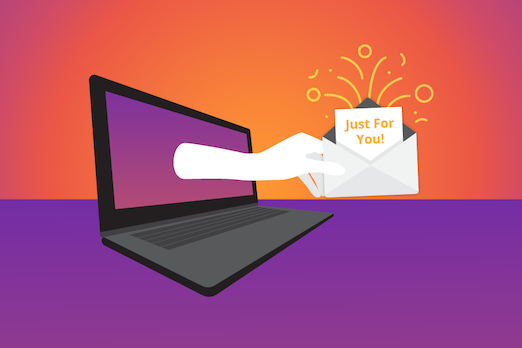
Contentstack recently hosted the second of a three-part webinar series. In the “Coming To Terms With Content Operations” webinar, Cathy McKnight from The Content Advisory presents new governance structures, workflows, and tasks to implement a successful content operation. The Content Advisory has helped brands such as Capital One, Hilton, Dell, and Caterpillar transform their marketing content into unforgettable customer experiences!
This webinar, along with this article are sure to give you valuable insights into building a successful content operation and deliver customer-experience-centric content.
When was the last time (if ever) you received an email addressed to “Dear Sir/Madam/Subscriber?” And when was that last time you didn’t delete such an email with record-breaking speed? After all, if a company doesn’t even know enough about you to know your name, how could they possibly have anything of personal value to offer you?
We’re witnessing a new era of content marketing. Gone are the days of the “one-to-many” marketing method that the advent of the radio ushered in in 1920. Exactly one century later, modern organizations the world over have shifted their focus to “one-to-one” content marketing that delivers personalized content, relevant purchasing journeys, and unique experiences at any scale.
Don’t be like those organizations that continue to waste their content marketing budgets on non-personalized campaigns that more and more consumers are ignoring by the day. Instead, keep reading to tune into the most significant trends that are changing content marketing and tap into several tools that will keep you competitive as the future of content marketing becomes ever-more personalized.
What Is Personalized Content Marketing?
Let’s start things off on the right foot by making sure we’re all on the same page about what personalized content marketing means. According to Gartner, personalization is “a process that creates a relevant, individualized interaction between two parties designed to enhance the experience of the recipient.”
When it comes to content marketing, personalization is achieved by gathering unique data about each consumer or customer and using it to create a tailored experience that helps them achieve their goals.
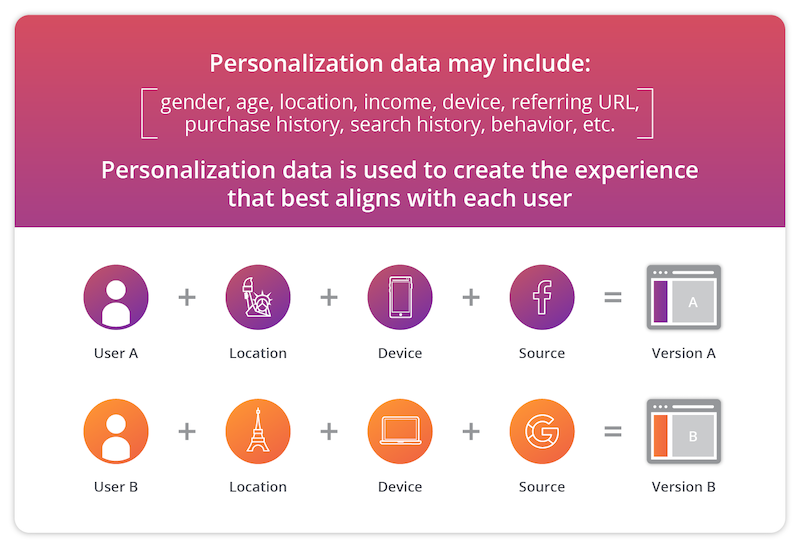
How The Future of Content Marketing Is Getting Personal
A study of marketers and marketing-adjacent roles from a diverse mix of industries found that 80% of marketers say personalized content is more or much more effective than non-personalized content.
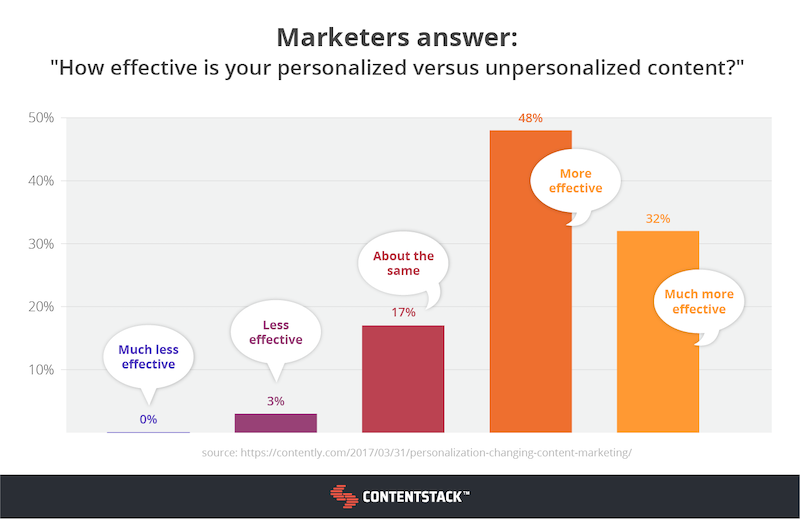
While “effective” means something slightly different at every organization, there are plenty of measurable business benefits of personalized content marketing. Benefits range from cutting acquisition costs in half to boosting conversion rates year over year, increasing purchase rates by 70%, growing consumer spending by as much as 500%, and more.
But it’s not only about the business benefits; consumers also expect and are more responsive to personalized content marketing. Right now, over 50% of consumers think companies should be able to use their data to suggest relevant products or services right when they’re needed. And over 70% of consumers will only engage with marketing messaging that’s personalized to them.
We think you’ll agree with us that the future of content marketing lies in personalization. Before we dive into the strategies that will help you become a leader in personalized content marketing that consumers love and competitors want to copy, let’s set the stage by getting to know the trends that got us to this point.
Technology Trends That Are Driving The Personalized Future of Content Marketing
Right about now, you might be thinking about the fact that plenty of brands have been creating marketing content based on audience segments for years, and you’d be right. What makes this topic relevant right now is that personalization goes beyond segmentation to deliver a genuinely one-to-one experience based on a person’s preferences, location, behavior, and more. These are the technology-powered trends that have enabled it to do so.
(Artificially) Intelligent Marketing Technology Takes Center Stage
As we’ve alluded to, true one-to-one content marketing personalization means looking at a segment of one to create and deliver relevant content in as close to real-time as possible. And as you’re well aware, this is a practically impossible task to execute successfully through manual means. Enter the artificial intelligence-powered marketing technology that more than a quarter of marketers are already using today.
A machine has artificial intelligence (AI) when it is capable of mimicking human cognitive activities. AI is a term that covers several different technologies, including machine learning (automatic “learning”), natural language processing (automatically “reading” human language), natural language generation (automatically “writing” and “speaking” human language), and more. AI-enabled technology can perform specific repetitive tasks as well as — or better than — humans so that they can focus on more cognitively-demanding roles.
When it comes to content marketing personalization specifically, AI-powered marketing technology aggregates and analyzes data from a variety of sources to make informed, real-time decisions about what content marketing messaging is best suited for a specific customer on a particular channel. This AI approach enables your organization to deliver accurate and timely one-to-one personalized content marketing via your websites, applications, email campaigns, social media ads, product recommendations, and more.
This tech-enabled trend is one that is certain to continue to impact marketing as well as many other industries considering predictions that the global artificial intelligence software market is going to grow by over 594% between 2020 and 2025.
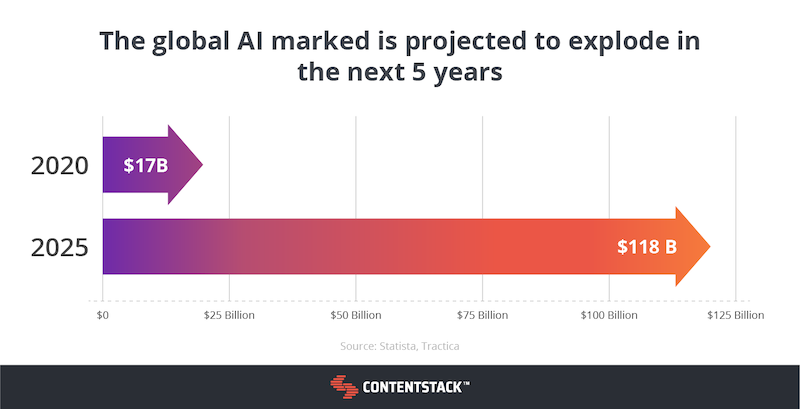
IoT Devices Drive Connectivity and Personalization Expectations
The internet of things (IoT) is a web of internet-connected devices with which you’re likely already familiar — smartphones, smartwatches, smart speakers, TVs, security systems, self-driving cars, and more. By 2030, expectations are that 125 billion IoT devices are going to be online, and the average consumer may own as many as 15 of them.
In other words, the consumer you want to reach probably already has an internet-connected device on their person most of the time. And, chances are, they’re expecting you to know how to deliver personalized content marketing to it. We know this because while mobile Google searches with local intent have risen, location “clues” like zip codes and cities have dropped.

Personalization Power Players Prepare Consumers
How does Amazon always seem to know what you need around the house? When did Netflix get so good at recommending shows you just can’t help but binge? And what is it about Spotify that always manages to get you pumped up for your workout?
It’s personalized marketing by way of recommendation engines. Recommendation engines use algorithms, A/B testing, and sometimes programs enabled by the AI technology we discussed above to recommend products and services that consumers will like. The recommendations come from personal data, such as age, location, income bracket, and previous purchases. Additionally, these engines can make comparisons to show what people similar to them have bought in the past.
Personalized marketing has helped create some of the most successful entertainment and shopping outlets by enabling them to make and sell offerings they already know consumers want. And, by doing so, these major players are normalizing personalization and making it easier for other organizations that want to follow in their footsteps.
How to Overcome the Challenges of Personalizing Your Content Marketing Campaigns
The top challenges that plague content marketers when it comes to creating and distributing personalized content marketing are lack of technology, lack of resources, and lack of the data needed to pull off personalization even if they had the time and the tech.
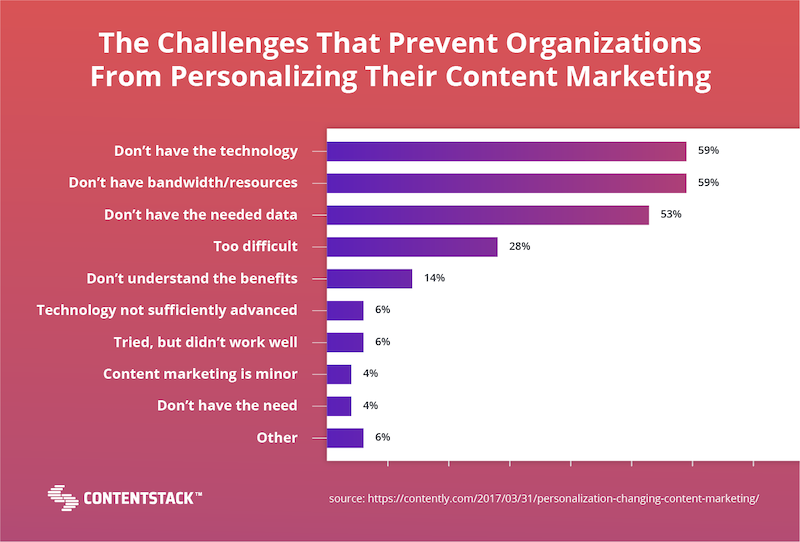
We understand that it’s hard to scale up content marketing efforts — especially of the highly-personalized variety — while you’re already neck-deep in a daily to-do list that doesn’t exactly have a lot of room for “stop everything you’re doing and start over.”
That’s why we put together the following strategies and recommended technologies that will help you overcome the challenges that keep most organizations from taking advantage of all that personalized content marketing has to offer.
Defeat Data Scarcity: How to Collect and Use Consumer Data
Personalizing content marketing for a specific consumer starts with knowing specifics about that consumer. So the critical first move in achieving personalized content marketing is collecting and utilizing as much data as you can about your consumers.
While you’ll likely need to update this list to match the information your marketing team wants and needs, here’s the kind of consumer data you’ll probably be looking to gather:
- Demographic information
- Name
- Age
- Location
- Job and income
- Marital status
- Family information
- Contextual information
- How frequently do they interact with your brand?
- Which content marketing messaging do they interact with the most?
- When do they interact? For example, do they show up on a predictable schedule (like maybe when their budget increases)? Or do they only respond to sales messaging?
- Which of your other consumers are they connected to, and what can that connection teach you about their preferences?
Both demographic and contextual information are essential because they’ll empower you to create and deliver content marketing that’s not just relevant but relevant in the context of your business. Knowing these things also gives insight into behavioral patterns that will help increase the accuracy and potency of your content marketing efforts over time.
The following tools will help you get started collecting and making the most of the consumer data you need, at the scale you want:
Suggested Data Collection and Activation Tools
- Social listening tools allow you to see at a glance what consumers are saying about your industry or your brand in particular. Try Hootsuite or Buffer.
- Sentiment analysis platforms can identify the underlying “feeling” (negative, positive, etc.) in text-based conversations that consumers are having about your organization. Check out IBM Watson, MonkeyLearn, Salesforce Einstein, or RapidMiner.
- Website analytics platforms enable you to see who’s on your website, where they came from, and how they’re engaging. Look at Google Analytics, Adobe Analytics, FullStory, HotJar, or Optimizely for these specifics as well as general consumer trends.
- Mobile application analytics help businesses collect similar user data but from mobile apps. Try Mixpanel or Countly.
- A data management platform (DMP) will help automate the gathering, segmenting, and integrating of data from your digital domains (first-party), partner domains (second-party), and aggregators (third-party). Check out LiveRamp or Clearbit to get a leg-up here.
A significant part of the power of your personalized marketing content strategy lies in how well you know your consumers. We highly recommend trying combinations and even alternatives to these tools until you’ve created the best system for collecting and using your consumer data.
Solve Resource Shortages: How to Personalize and Distribute Content Marketing At Scale
The most manual part of creating personalized content marketing should be the part where you bust out your word processor of choice to write the words down. From there, the key to resolving resource shortages is implementing technology that takes care of the repetitive, manual, or difficult-to-scale personalization tasks.
It’s an ideal job for a headless content management system (CMS). A headless CMS platform easily integrates with personalization tools to layer the insights gleaned above to create, optimize, and deliver content that a specific consumer wants to see, where they want to see it, and when they want to see it, at whatever scale you need.
With a headless CMS, entire organizations can collaborate on, manage, and publish marketing content similar to a traditional CMS. The difference is underneath the hood, where a headless CMS uses application programming interfaces (APIs) to separate content from programming and design. This headless approach empowers marketers to create high-value content, optimize it for use with personalization technology, and distribute it without worrying about having to ask for tech support.
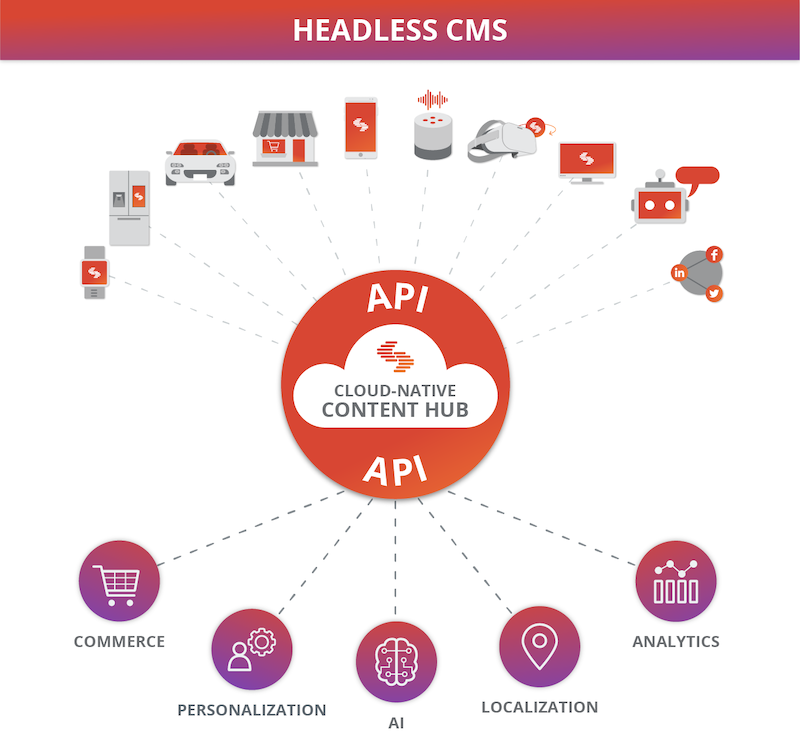
Contentstack is one such headless CMS that is built for content marketing personalization integrations. Contentstack simplifies integrating best-in-class customer relationship management (CRM) platforms, translation services, AI tools, A/B testing applications, analytics parsing, and plenty more.
On that note, here’s a whole host of recommended technologies we suggest trying out to create a smooth and scalable content marketing personalization and publishing workflow:
Suggested Content Personalization and Distribution Tools
- For scalability, it’s essential to implement a single platform that works as a content hub for creating, storing, optimizing, managing, and distributing content. Contentstack is an exceptionally user-friendly and integration-focused CMS.
- A customer relationship management (CRM) platform will mix in data about your ongoing customer relationships. We recommend looking at Salesforce, HubSpot CRM, Zendesk, Intercom, or Insightly.
- A customer data platform (CDP) enables you to layer data on top of what you know about your customers and leads to build a complete profile. Evergage and Exponea are good options.
- Translational and localization software is a must to capture the lingual and cultural nuances of your consumers. Contentstack has built-in language and localization features. You can also check out translations.com, Smartling, or Localize.
- Finally, A/B testing applications will help you nail down which personalization efforts are working and how to keep improving. See Monetate, Optimizely, or AB Tasty.
Bring It All Together: How to Get Your Marketing Department Organized Around Your Personalization Efforts
All the technology and strategies above aren’t going to do you much good if the actual content marketers who need to implement them flawlessly aren’t on the same page. So, how do you get what might be multiple marketing teams that may be scattered all over the world on the same page when it comes to something as important as the future of content marketing at your organization?
You invest in implementing content operations and a governance structure that informs how to create, manage, and distribute content so that it always aligns with your content marketing personalization goals no matter how the location, language, or offering changes.
Pretty aspirational, right? We agree, but we also know you can make it a reality at your organization with the proper guidance that comes from Cathy McKnight, VP of Strategy and Consulting at The Content Advisory.
Join the hundreds of marketing professionals that watched the live webinar, by viewing the recorded part two of our “Modern Content Marketing in Practice” webinar series: “Coming To Terms With Content Operations” This webinar covers the ten tactical steps to scalable content operations, how exactly to implement governance structures and workflows, and how to prioritize these tasks based on your current maturity level. You’ll also get access to the “Ten Steps to Scalable Content Operations Workbook,” which is a useful roadmap for your content operations transformation.
Keep Learning About How Your Organization Can Take Part in the Future of Content Marketing
If you’re interested in learning more about what you can do to modernize your content marketing efforts, we invite you to join us for the third installment of the Modern Content Marketing in Practice webinar series: “Measuring Content Marketing Experiences.” The webinar takes place on Tuesday, May 12th, 2020, at 8 AM PDT (11 AM EDT | 3 PM GMT | 16.00 CET).
We also recommend that you check out the first installment “How to Make Content Marketing Work for You,” where Tim “The Doctor” Walters, Principal Strategist and Privacy Lead at The Content Advisory, walks you through executing content strategies that have tangible results.
About Contentstack
The Contentstack team comprises highly skilled professionals specializing in product marketing, customer acquisition and retention, and digital marketing strategy. With extensive experience holding senior positions at renowned technology companies across Fortune 500, mid-size, and start-up sectors, our team offers impactful solutions based on diverse backgrounds and extensive industry knowledge.
Contentstack is on a mission to deliver the world’s best digital experiences through a fusion of cutting-edge content management, customer data, personalization, and AI technology. Iconic brands, such as AirFrance KLM, ASICS, Burberry, Mattel, Mitsubishi, and Walmart, depend on the platform to rise above the noise in today's crowded digital markets and gain their competitive edge.
In January 2025, Contentstack proudly secured its first-ever position as a Visionary in the 2025 Gartner® Magic Quadrant™ for Digital Experience Platforms (DXP). Further solidifying its prominent standing, Contentstack was recognized as a Leader in the Forrester Research, Inc. March 2025 report, “The Forrester Wave™: Content Management Systems (CMS), Q1 2025.” Contentstack was the only pure headless provider named as a Leader in the report, which evaluated 13 top CMS providers on 19 criteria for current offering and strategy.
Follow Contentstack on LinkedIn.






.svg?format=pjpg&auto=webp)
.svg?format=pjpg&auto=webp)
.png?format=pjpg&auto=webp)






.png?format=pjpg&auto=webp)


